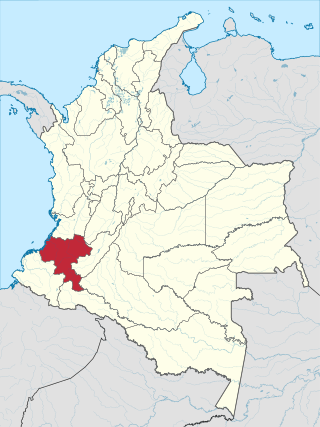
Cauca Department is a department of Southwestern Colombia. Located in the southwestern part of the country, facing the Pacific Ocean to the west, the Valle del Cauca Department to the north, Tolima Department to the northeast, Huila Department to the east, and Nariño Department to the south. Putumayo and Caqueta Departments border the southeast portion of Cauca Department as well. It covers a total area of 29,308 km2 (11,316 sq mi), the 13th largest in Colombia. Its capital is the city of Popayán. The offshore island of Malpelo belongs to the department. It is located in the southwest of the country, mainly in the Andean and Pacific regions plus a tiny part (Piamonte) in the Amazonian region. The area makes up 2.56% of the country.

Donald William Felder is an American musician who was the lead guitarist of the rock band Eagles from 1974 to 2001. He was inducted into the Rock and Roll Hall of Fame in 1998 with the Eagles. Felder was inducted into the Musicians Hall of Fame and Museum in 2016.

Barbacoan is a language family spoken in Colombia and Ecuador.
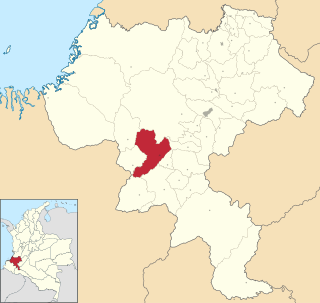
Patía is a Municipality located in Cauca Department, Colombia. The administrative centre of Patía is El Bordo.

Timbiqui is a town and municipality in the Cauca Department, Colombia. It is located on the Pacific Coast of Colombia on the estuary of the Timbiqui River. An earthquake affected its inhabitants on the first of October, 2012.

Because of its natural structure, Colombia can be divided into six distinct natural regions. These consist of the Andean Region, covering the three branches of the Andes mountains found in Colombia; the Caribbean Region, covering the area adjacent to the Caribbean Sea; the Pacific Region adjacent to the Pacific Ocean; the Orinoquía Region, part of the Llanos plains mainly in the Orinoco river basin along the border with Venezuela; the Amazon Region, part of the Amazon rainforest; and finally the Insular Region, comprising the islands in both the Atlantic and Pacific Oceans. Colombia is located in South America.
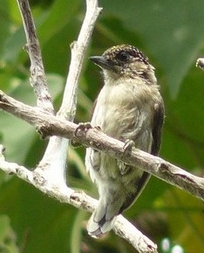
The Cauca Valley dry forests is a tropical dry broadleaf forest ecoregion in Colombia.
Bosque Seco del Patía Fauna and Flora Sanctuary, or Patia Dry Forest, is a wildlife sanctuary in Colombia. It is located on the border between the Nariño Department and the Cauca Department.

The Patía River is a river in southwestern Colombia. It flows over 400 kilometres (250 mi) to drain into the Pacific Ocean north of Tumaco. The Patía River is the longest river on the Colombian Pacific Coast. The last 90 kilometres (56 mi) is navigable by boat.
Anacrusis is a genus of moths belonging to the subfamily Tortricinae of the family Tortricidae.
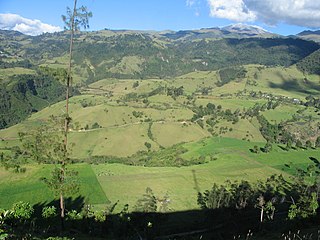
The Puracé National Natural Park is a national park located in the Andean region of Colombia, southeast of the city of Popayán in the Cordillera Central range. Its main feature is the active stratovolcano Puracé, one of Colombia's most active volcanoes. Four of the country's most important rivers originate within the area: Magdalena River, Cauca River, Japurá River and Patía River.
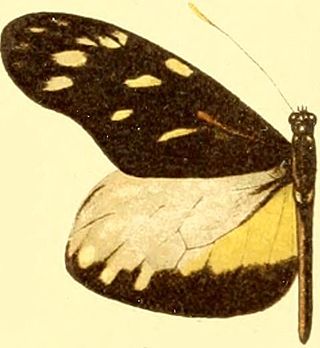
Patia cordillera is a butterfly in the family Pieridae. It is found from Costa Rica to Colombia and Ecuador.

Nudo de los Pastos, in English meaning "Knot of the Pastos" or also known as the "Massif of Huaca", is an Andean orographic complex located in the Ecuadorian province of Carchi and the Colombian department of Nariño. It covers the intricate mountain region where the Andes splits into two branches on entering Colombia: the Cordillera Occidental and the Cordillera Central.
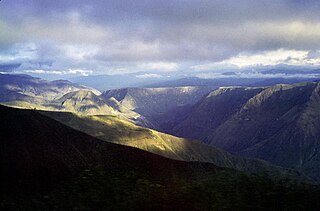
The Sickle of Minamá is a deep depression located in southwestern Colombia, in the territories of the Nariño and Cauca Departments, created by the Patía River at its outlet to the Pacific Ocean, and is part of the upper valley Patía.
Patia railway station is a small railway station in Bhubaneswar, Odisha. Its code is PTAB. The station consists of two platforms. The platforms are not well sheltered. It lacks many facilities including water and sanitation.

The Marañón dry forests (NT0223) is an ecoregion in northern Peru. It covers the lower valley of the Marañón River and its tributaries along the eastern edge of the Andes. It has a dry climate due to rain shadow from mountains further east. The habitat has long been modified by farming, ranching and logging and is now threatened by construction of hydroelectric and irrigation dams.

The Patía Valley dry forests (NT0225) is an ecoregion in southwestern Colombia. It covers a dry valley surrounded by mountains. The original habitat has mostly been destroyed by human activity, although a few pockets remain.

The Northwestern Andean montane forests (NT0145) is an ecoregion on the Andes mountains in the west of Colombia and Ecuador. Both flora and fauna are highly diverse due to effect of ice ages when the warmer climate zones were separated and the cooler ones combined, and interglacial periods when the reverse occurred. Because the environment is hospitable to humans, the habitat has been drastically modified by farming and grazing since the Pre-Columbian era.
Tupou Patia-Brogan is a football player and referee from the Cook Islands. In 2015, Patia served as a referee at the 2015 FIFA Women's World Cup in Canada, becoming the first person from the Cook Islands, male or female, to serve as a referee at a FIFA World Cup-affiliated match.














